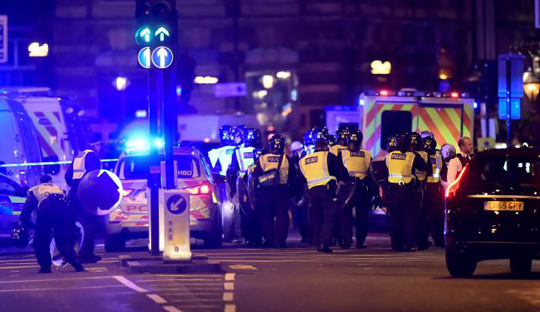London, Jun 4: Seven people are confirmed to have died in an attack by three assailants who drove a van at pedestrians on London Bridge before stabbing people in the nearby Borough Market area, London's Metropolitan Police chief Cressida Dick said on Sunday.

"It has now been confirmed sadly that seven members of the public have died. In addition, as you know, we believe, three suspects are dead," she said in a televised statement.
Dick said police believed the incident was under control, but officers needed to conduct a thorough search of the area to ensure everyone was accounted for and no further suspects were at large.
"Our priority now is to work with our colleagues in the national counter-terrorism police network and also with the intelligence agencies and other security services to establish more details about these individuals who carried out the attack and the background to it," she said.
The BBC showed a photograph of two possible London attackers shot by police, one of whom had canisters strapped to his body. Hours after the attack the area remained sealed off.
The London ambulance service said at least 48 people had been taken to six hospitals across the city. Three major London hospitals said that they were on lockdown to keep patients and staff safe.
A reporter said some time after the attack began that he had heard loud bangs near the Borough Market area.
Streets around London Bridge and Borough Market, fashionable districts packed with bars and restaurants, would have been busy with people on a Saturday night out. BBC showed dozens of people, evidently caught up in the attack, being escorted through a police cordon with their hands on their heads.
Witnesses described a white van careering into pedestrians near London Bridge and knocking over several people.
"It looked like he was aiming for groups of people. I froze beacause I didn't know what to do," Mark Roberts, 53, a management consultant, told Reuters. He saw at least six people on the ground after the van veered on and off the pavement.
"It was horrendous," he said.
A taxi driver told the BBC that three men got out of the van with long knives and "went randomly along Borough High Street stabbing people."
Witnesses said people ran into a bar to seek shelter.
"People started running and screaming, and the van crashes into the railing behind. We went towards Borough Market and everyone went inside (the bar). Everyone in the bar started pushing people from the exits," one witness who gave his name as Brian, 32, told Reuters.
Another witness, who declined to be named, his white top covered in blood, described a scene of panic in the bar.
"They hit the emergency alarm. There was a line of people going down to the emergency exit. And then people started screaming coming back up," the 31-year-old said.
"Around the corner there was a guy with a stab wound on his neck ... There was a doctor in the pub and she helped him. They put pressure on the stab wound."
BBC radio said witnesses saw people throwing tables and chairs at the perpetrators of the attack to protect themselves.
Islamic State call
Islamic State earlier on Saturday sent out a call on instant messaging service Telegram urging its followers to launch attacks with trucks, knives and guns against "Crusaders" during the Muslim holy month of Ramadan.
Similar attacks, in Berlin, Nice, Brussels and Paris, have been carried out by militants over the past couple of years.
"Following updates from police and security officials, I can confirm that the terrible incident in London is being treated as a potential act of terrorism," Prime Minister Theresa May said.
London's Thames river police said it was working with the lifeboat rescue service to help evacuate people caught up in the attack, described by police as a terrorist incident.
US President Donald Trump took to Twitter to offer US help to Britain. The White House said he had been briefed on the incidents by his national security team.
One woman told Reuters she saw what appeared to be three people with knife wounds and possibly their throats cut at London Bridge at the Thames river. Reuters was unable to immediately verify her account.
Stabbings on the street
The incident bore similarities to a March attack on Westminster Bridge, west of London Bridge, in which a man killed five people after driving into a crowd of pedestrians before stabbing a police officer in the grounds of parliament.
Several witnesses also reported hearing gunshots around London Bridge.
"We were in an Uber (taxi) going towards London Bridge and suddenly we saw people running. The Uber stopped, we asked people what was going on - people said there was shooting," said Yoann Belmere, 40, a French banker living in London.
"Now the area is completely closed with police cars going one way and ambulances going the other," he said.
A witness said two men had entered a restaurant in the Borough Market area and stabbed two people inside. He said a waitress was stabbed in the throat and a man was stabbed in the back.
The Manchester bombing on May 22 was the deadliest attack in Britain since July 2005, when four British Muslim suicide bombers killed 52 people in coordinated attacks on London's transport network.






Comments
Add new comment